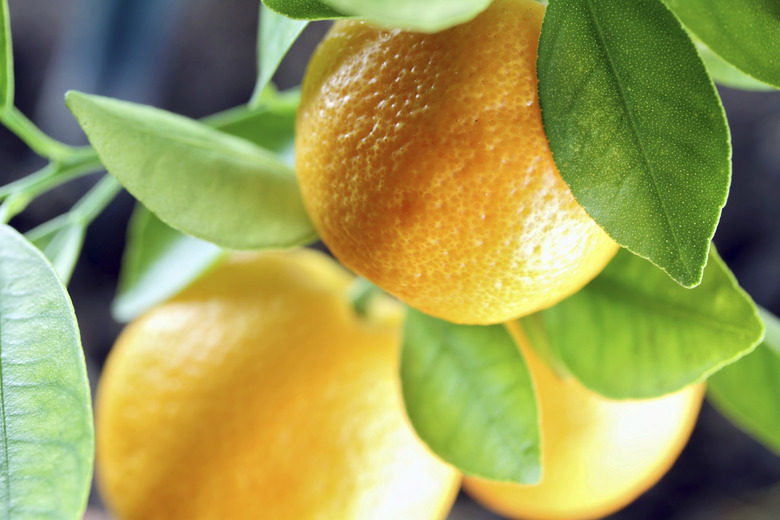Why Does Citrus Fruit Split Open Before It's Ripe?
Although relatively easy to grow, the fruit from citrus trees (Citrus spp.) occasionally splits open before it's ripe. Any type of citrus can suffer rind splitting, and it's usually caused by excessive water uptake and heavy fruit loads. Once the citrus fruit has split, you can't do anything to fix it.
Although relatively easy to grow, the fruit from citrus trees (Citrus spp.) occasionally splits open before it's ripe. Any type of citrus can suffer rind splitting, and it's usually caused by excessive water uptake and heavy fruit loads. Once the citrus fruit has split, you can't do anything to fix it. Although rainy weather is out of your control, you can still take a few steps to help prevent losing citrus fruit to rind splitting.
Too Much Water
Citrus rinds split when the fruit receives water so quickly the peel can't expand fast enough to accommodate the increased volume. Rinds that have suffered sunburn or drought stress are more susceptible to splitting because the peels lose their elasticity. Fruit splitting often happens after hot, windy weather. The hot winds cause drought stress, which makes the trees draw water from their fruit. Then when you give your tree a heavy watering, the pulp swells so quickly the dried rinds crack open under the pressure.
- Although relatively easy to grow, the fruit from citrus trees (Citrus spp.)
- Citrus rinds split when the fruit receives water so quickly the peel can't expand fast enough to accommodate the increased volume.
Preventing Rind Splitting
Change how you care for your citrus tree to help you prevent rind splitting due to excessive water uptake. Water your citrus tree regularly throughout the growing season, applying water at the drip line and 12 inches beyond so the root tips can absorb the moisture. Moisten the soil to a depth of 18 to 24 inches for young trees, and 36 inches for mature citrus trees. Allow the top 3 inches of soil to dry before watering again. Applying a 4- to 6-inch layer of organic mulch around the drip line can help maintain consistent soil moisture as well as soil temperatures. Compost, wood chips and chopped leaves all make good mulching materials. Make sure the mulch doesn't touch the tree's trunk, as that can lead to disease. Whenever hot, windy weather is predicted for your area, lightly water citrus trees several days beforehand. Continue lightly moistening the soil for a few days afterward to give your tree a few days to recover before going back to your regular watering schedule.
- Change how you care for your citrus tree to help you prevent rind splitting due to excessive water uptake.
- Water your citrus tree regularly throughout the growing season, applying water at the drip line and 12 inches beyond so the root tips can absorb the moisture.
Heavy Fruit Loads
Allowing a citrus tree to produce too many fruit increases the chances of rind splitting. A heavy fruit load means the tree must divide the available water and nutrients, which leads to lower quality fruits with thinner skins. Removing some of the fruits helps ensure that each remaining fruit develops a thick, elastic rind that will be less likely to split open under pressure.
Preventing Heavy Fruit Loads
Thin out citrus tree loads when the young fruit reaches about 1 inch in diameter. Start by removing any obviously deformed, blemished or abnormally small fruits first. Then remove healthy fruit until the remaining fruit is spaced 2 to 6 inches apart.
Thinning out the fruit by hand is the most effective way to lighten a tree's load, but it is time-consuming. Pole-thinning is faster and easier, particularly for removing fruit from higher branches, but it won't give you the same accuracy as hand-thinning. Before pole-thinning, wrap a thick layer of tape or cloth around the end of the pole so you're less likely to injure the limbs. Strike the fruit you wish to remove until it drops to the ground. Discard thinned fruit in a covered trash can to avoid attracting pests and fungal disease pathogens.
- Allowing a citrus tree to produce too many fruit increases the chances of rind splitting.
- Before pole-thinning, wrap a thick layer of tape or cloth around the end of the pole so you're less likely to injure the limbs.
References
- University of California Agriculture and Natural Resources: Navel Orange Split
- University of Florida Nassau County Extension: Citrus
- Floridata: Citrus Sinensis
- University of California Master Gardeners of Orange County: Citrus, Growing
- NapaValleyRegister.com: How to Protect Your Citrus Crop
- University of California Agriculture and Natural Resources: Growing Citrus in Sacramento
